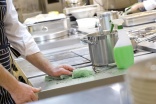Home › magazine › product features › Food hygiene don’t risk your reputation
Food hygiene - don’t risk your reputation
4th of August 2015Staff in a busy kitchen may be rushed off their feet, but there must be a full understanding that a good cleaning regime should never be compromised.
Cleaning surfaces, sanitising floors, cleaning cookers, washing the hands – what are the key cleaning tasks that need to be carried out on a regular basis in any food service kitchen? And what are the best products for the job? Antoine Rocourt, marketing lead in kitchen care for Diversey Care, writes exclusively for ECJ.
You can’t change a customer’s first impression of your restaurant. From the moment guests walk through the front door, they are looking for a clean, visually-pleasing environment. Diners’ expectations are high and the overall dining experience is what will make them return. As an operator, your commitment to creating a superior dining experience is of course reflected in the quality of the food and the level of service, but is also in the tidiness and cleanliness of the restaurant, washrooms and kitchen areas.
Various studies have shown that to a potential guest the cleanliness, in particular tableware, interiors, food prep areas and public washrooms, are among the top considerations when determining where to eat. It has an even stronger impact on the decision whether to come back or not; two out of three people will not return to a restaurant if any of the dining area, staff or crockery/cutlery is dirty. Taking that into account, cleaning is not a just cost, but a critical revenue factor.
Safe food
Food safety is obviously just as important and high priority. You will not intentionally risk your customers’ or employees’ health, or the reputation of your business. Although individual incidents of foodborne illness do occur in today’s world, widespread outbreaks can be front page news and result in negative backlash. Food hygiene offences can also be very costly. On top of the fine, there may be civil action by food poisoning victims or even forced business closure. Keeping a kitchen clean and hygienic is not so difficult. There are many guidelines and instructions on how to ensure food safety, so authorities and courts have no sympathy with poor cleaning and unsafe food handling practices.
It is thus critical to choose the right products and cleaning methods, and implement a hygiene plan that clearly tells everybody what to clean when and how.
Market leading suppliers will help you with trusted products, strong application expertise and regulatory support. They have significant groups of specialists to guarantee product safety and regulatory compliance, and experts to solve unique problems that may occur in the market. These suppliers also invest major R&D effort to explore new technologies and optimise their product solutions in terms of efficiency, safety and sustainability. They develop, for example, highly concentrated cleaners in unique safe, closed, recyclable packaging with very accurate dosing and dilution capabilities.
Low cost products may take longer or take more effort to get a job done, or these products may be less safe or have a greater impact on the environment due to under or over-dosing, chemical composition, or packaging format.
Wrong products may also damage ware, facilities or equipment. The total value of kitchen equipment in a modest kitchen can be over100,000 euro. Such a big investment needs to be protected. Correct cleaning can make it last longer and be more efficient.
Using a good proven range of cleaning chemicals is less risky and less expensive in the longer run.
Which products?
When choosing your products, think about the objects to clean. Is it a food contact area that requires frequent sanitation or disinfection? Think about the sort of soil to be cleaned. Is it heavy or light soiled? Protein or grease? What equipment or tools are available to make the process easier? Is the surface vulnerable, and how often is it to be cleaned?
For example: what is the floor made of? Special safety or simple quarry tiles? How big is the area to clean? Could you use a machine which will make the cleaning process easier and more efficient?
One of the biggest cause of accidents in commercial kitchens is slips, trips and falls. It is about a third of all major reported injuries. The cost to an employer of a reportable injury can be very high – insurance, sick pay, agency labour, management time and legal costs. The individual will also bear costs, not least of which is the distress. So how much may a good floor cleaning product really cost?
Ovens and grills are tough to clean as they have burnt-on soils. They need a strong product and effective tool. However, there are also special oven cleaners that work with high temperatures so you don’t need to wait to let the oven or grill cool down before cleaning, saving precious time. Many new combi ovens have automatic cleaning systems. This is obviously the most convenient and easy way of cleaning. Unfortunately the original oven manufacturers often state that only their approved products may be used to guarantee continued maintenance and service. Major suppliers will however ensure that their products are compatible with commonly used materials.
Cooker hoods and fat fryers also need a good degreaser. Oven trays and plates can be particularly difficult to clean due to the carbonised soil, and these items are usually too large to clean in a dishwasher. Overnight soaking in a bath with carbon removing degreaser could in that case save a lot of effort and time. Watch out with alumina items: use special soft-metal safe products.
Drains and fat traps can be quickly overlooked. Yet they need regular cleaning and maintenance to avoid blockage. Here biological (bacteria or enzyme based) systems can be very effective when installed correctly to provide a regular and constant level of grease and fat degrading activity. The drain itself also needs regular cleaning to avoid the build-up of biofilms and growth of risky bacteria such as listeria.
The dishwasher will be the single biggest user of chemicals: detergent for effective cleaning and rinse aid for quick and spotless drying. There are products that combine both detergent and rinse aid into a single all-in-one product, saving space and making the process even simpler. Most products are liquids, but there are also powder and solid systems. These are more concentrated, use less packaging, and thus provide a significant environmental and sustainability advantage.
They are also packed in closed systems, avoiding operator contact with the chemicals.
In hard water areas, an acidic descaling product may be needed to remove potential scale formed when water is heated – for example in the dishwasher, bain-marie, or boiler. In those cases it is also more efficient to use a special hard water dish wash detergent and acidic rinse aid.
A stainless steel polish can be used to make all metal surfaces of the kitchen (fridges, tables) gleam and shine.
Finally, as well as food soils, people bring in dirt and germs. This makes the correct use of disinfectants and sanitisers so crucial. Sanitiser means a product that cleans and disinfects in one operation instead of separate steps. These products should meet strict bactericidal regulations and their registration include specific conditions of use (dosage, exposure time and temperature). An effective kitchen sanitiser is vital to help control bacterial growth and ensure food safety.
Good personal care and regular hand washing are key to hygiene and food safety. A soap with anti-bacterial properties is highly recommended.
It all sounds like a lot of products, but usually you can clean and maintain over 80 per cent of a kitchen with about seven daily cleaning products. In smaller kitchens you can also choose to use special multifunctional products, dosed at different dilutions for specific applications.
Extending cleaning to the front of the restaurant, you should add a toilet, bathroom and glass cleaner, and perhaps a special lobby and carpet cleaner. Check the suitability of those cleaners when wood or delicate upholstery such as leather is used in the restaurant.
And don’t forget to select a range a hygienic cleaning tools – they can make cleaning so much more effective. Make sure they are coloured-coded to avoid cross contamination risks, and that they are so robust that they can be washed in a dishwasher.
It is in the offering of specialised products, in products that are more efficient, sustainable and safe, and in providing a complete array of solutions for all cleaning and hygiene jobs, that the major leading suppliers differentiate themselves from many of the local suppliers.











